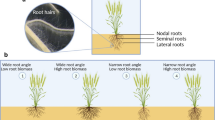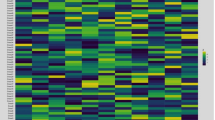Abstract
An investigation was carried out with 25 populations of Rauwolfia serpentina to assess variability, association of yield components and their direct and indirect effects on yield. Analysis of variance revealed significant differences among 25 populations of R. serpentina for all the traits. Heritability estimates in broad sense were high for most of the traits and moderate for number of primary root branch. As in case of heritability, expected genetic advance was the highest for plant height, number of primary stem branch, reserpine content (%) in root, the most important trait for commercial utilization. Correlation analysis indicated positive and significant phenotypic correlation of reserpine content with root length and total alkaloid content (%) and significant negative association with root diameter. The partitioning of genotypic correlation coefficient into direct and indirect effects revealed total alkaloid content and root yield were the most important direct contributors to reserpine percent in root. It is concluded that accessions with more alkaloid content and root length are likely to yield more reserpine content in root and these characters can be considered to be reliable traits for selection of high reserpine content in root.


Similar content being viewed by others
References
Bhagat NR, Mital SP, Hardas MW (1980) Variation in Rauwolfia serpentina genetic resources in India. Euphytica 29:747–750
Bhargava A, Shukla S, Kumar R, Ohri D (2009) Metroglyph analysis of morphological variation in Chenopodium spp. World J Agric Sci 5(1):117–120
Biswas RC (1970) Rauwolfia serpentina-influence of different levels of nitrogen and defloration treatments on total yield of roots and alkaloid content. J Sci Cult 36(8):463–465
Brezinova B, Macak M, Eftimova J (2009) The morphological diversity of selected traits of world collection of poppy genotypes (genus Papaver). J Cent Eur Agric 10(2):183–190
Burton GW (1952) Quantitative inheritance in grasses. Proc Sixth Int Grassl Cong 7:277–283
Campbell EO, Markham KR, Moore NA, Porter LJ, Wallace JW (1979) Taxonomic and phylogenetic implications of the comparative flavonoid chemistry of species in the family Marchantiacea. J Hattori Bot Lab 45:185–199
Dalkani M, Darvishzadeh R, Hassani A (2011) Correlation and sequential path analysis in Ajowan (Carum copticum L.). J Med Plants Res 5(2):211–216
Das A, Datta AK, Ghose S, Bhattacharyya A (2011) Genetic analysis in Poshita and Jawahar 22 Varieties of Withania somnifera (L.) Dunal (Solanaceae). Plant Arch 11(1):59–62
Dhruv KS, Srivastava B, Sahu A (2004) Spectrophotometric determination of Rauwolfia alkaloids: estimation of reserpine in pharmaceuticals. Anal Sci 20:571–573
Franklin EC (1979) Model relating levels of genetic variance to stand development of four North American Conifers. Silvae Genetica 28:207–212
Ginwal HS, Mandal AK (2004) Variation in growth performance of Acacia nilotica Wild ex Del. provenances of wide geographical origin: six year results. Silvae Genet 53(5–6):264–269
Hanson CH, Robinson HF, Comstock RE (1956) Biometric studies of yield in segregating population of Korean Lespedezer. Agron J 48:268–272
Jain SP, Singh J, Singh SC (2003) Rare and endangered medicinal and aromatic plants of Madhya Pradesh. J Econ Taxon Bot 27:925–932
Johnson HW, Robinson HF, Comstock RE (1955) Estimation of genetic and environmental variability in soybean. Agron J 47:314–318
Lush JL (1949) Heritability of quantitative characters in farm animals. Heriditas 35(suppl):256–261
Namkoong G, Conkle MT (1976) Time trends in genetic control of height growth in ponderosa pine. For Sci 22:2–12
Namkoong G, Usanis RA, Silen RR (1972) Age-related variation in genetic control of height growth in douglas-fir. Theor Appl Genet 42:151–159
Panse V G, Sukhatme PV (1967) Statistical Methods for Agriculture Workers. ICAR Publication, New Delhi
Rajendra KD, Souza L (1999) In vitro propagation of ayurvedic plants. In: Khan IA, Khanum A (eds) Role of biotechnology in medicinal and aromatic plants. Ukaaz Pub., Hyderabad, pp 207–215
Shehbaz Khan M, Bahuguna DK, Kumar R, Kumar N, Ahmad I (2012) Study on genetic variability and heritability in Ocimum spp. Hort. Flora Research Spectrum 1(2):168–171
Shivanna J, Ravi CS, Sreeramu BS (2007) Character association and path coefficient analysis among economic traits in makoi (Solanum nigrum L.). Karnataka J Agric Sci 20(3):575–577
Singh AK, Singh HP, Singh SP, Kalra A (2008) Genetic variability and correlation studies for selection criteria in safed musli (Chlorophytum borivilianum, Santapau). Commun Biom Crop Sci 3(2):67–71
Srivastava A, Tripathi AK, Pandey R, Verma RK, Gupta MM (2006) Quantitative determination of reserpine, ajmaline, and ajmalicine in Rauwolfia serpentina by reversed-phase high-performance liquid chromatography. J Chromatogr Sci 44(9):557–560
Tyler VE, Brady LY, Robbers JE (1981) Pharmacognosy, 8th edn. Lea and Febiger, Philadelphia, pp 61–63
Vashistha R, Nautiyal BP, Nautiyal MC (2006) Conservation status and morphological variations between populations of Angelica glauca Edgew and Angelica archangelica Linn, in Garhwal Himalaya. Curr Sci 91(11):1537–1542
Acknowledgments
Financial support from the National Medicinal Plants Board, Ministry of Health and Family Welfare, New Delhi (Sanction No. GO/MP/-07/2006) is gratefully acknowledged.
Author information
Authors and Affiliations
Corresponding author
Rights and permissions
About this article
Cite this article
Usmani, G., Chawhaan, P.H., Mishra, Y. et al. Variability, heritability and character association analysis of chemoagronomic traits in Rauwolfia serpentina . Euphytica 200, 259–268 (2014). https://doi.org/10.1007/s10681-014-1153-x
Received:
Accepted:
Published:
Issue Date:
DOI: https://doi.org/10.1007/s10681-014-1153-x




